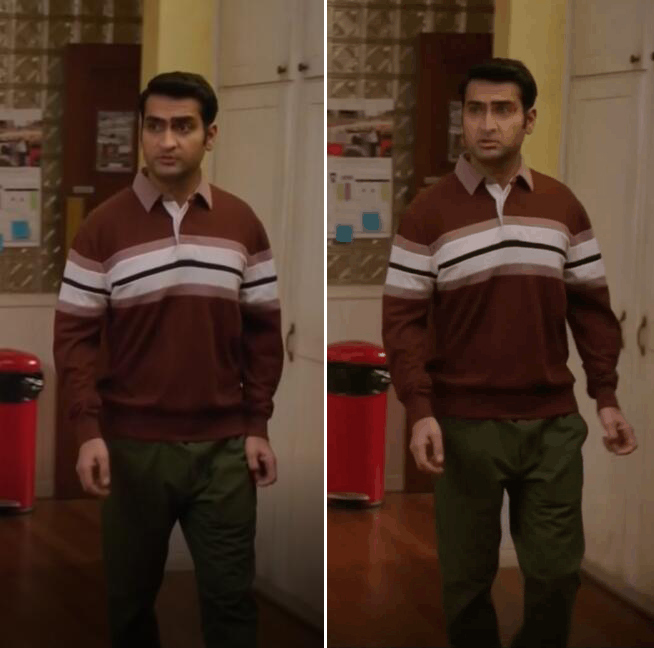1.准备工作,按博主的环境为准
Python 3.5
Opencv 3
Tensorflow 1.3.1
Keras 2
cudnn和CUDA,如果你的GPU足够厉害并且支持的话,可以选择安装
那就先安装起来,有兴趣的朋友给我个暗示,好让我有动力写下去,想实现整套的功能还是有点复杂的
第一部分,数据采集,及视频内人物脸
import cv2 save_path = 'your save path' cascade = cv2.CascadeClassifier('haarcascade_frontalface_alt.xml path') cap = cv2.VideoCapture('your video path') i = 0 while True: ret,frame = cap.read() gray = cv2.cvtColor(frame,cv2.COLOR_BGR2GRAY) rect = cascade.detectMultiScale(gray,scaleFactor=1.3,minNeighbors=9,minSize=(50,50),flags = cv2.CASCADE_SCALE_IMAGE) print ("rect",rect) if not rect is (): for x,y,z,w in rect: roiImg = frame[y:y+w,x:x+z] cv2.imwrite(save_path+str(i)+'.jpg',roiImg) cv2.rectangle(frame,(x,y),(x+z,y+w),(0,0,255),2) i +=1 cv2.imshow('frame',frame) if cv2.waitKey(1) &0xFF == ord('q'): break cap.release() cv2.destroyAllWindows()
第二部分,国外大神开源代码,用于模型训练
import cv2 import numpy from utils import get_image_paths, load_images, stack_images from training_data import get_training_data from model import autoencoder_A from model import autoencoder_B from model import encoder, decoder_A, decoder_B try: encoder .load_weights( "models/encoder.h5" ) decoder_A.load_weights( "models/decoder_A.h5" ) decoder_B.load_weights( "models/decoder_B.h5" ) except: pass def save_model_weights(): encoder .save_weights( "models/encoder.h5" ) decoder_A.save_weights( "models/decoder_A.h5" ) decoder_B.save_weights( "models/decoder_B.h5" ) print( "save model weights" ) images_A = get_image_paths( "data/trump" ) images_B = get_image_paths( "data/cage" ) images_A = load_images( images_A ) / 255.0 images_B = load_images( images_B ) / 255.0 images_A += images_B.mean( axis=(0,1,2) ) - images_A.mean( axis=(0,1,2) ) print( "press 'q' to stop training and save model" ) for epoch in range(1000000): batch_size = 64 warped_A, target_A = get_training_data( images_A, batch_size ) warped_B, target_B = get_training_data( images_B, batch_size ) loss_A = autoencoder_A.train_on_batch( warped_A, target_A ) loss_B = autoencoder_B.train_on_batch( warped_B, target_B ) print( loss_A, loss_B ) if epoch % 100 == 0: save_model_weights() test_A = target_A[0:14] test_B = target_B[0:14] figure_A = numpy.stack([ test_A, autoencoder_A.predict( test_A ), autoencoder_B.predict( test_A ), ], axis=1 ) figure_B = numpy.stack([ test_B, autoencoder_B.predict( test_B ), autoencoder_A.predict( test_B ), ], axis=1 ) figure = numpy.concatenate( [ figure_A, figure_B ], axis=0 ) figure = figure.reshape( (4,7) + figure.shape[1:] ) figure = stack_images( figure ) figure = numpy.clip( figure * 255, 0, 255 ).astype('uint8') cv2.imshow( "", figure ) key = cv2.waitKey(1) if key == ord('q'): save_model_weights() exit()
第三部分,国外大神开源代码,人脸输出
import cv2 import numpy from pathlib import Path from utils import get_image_paths from model import autoencoder_A from model import autoencoder_B from model import encoder, decoder_A, decoder_B encoder .load_weights( "models/encoder.h5" ) decoder_A.load_weights( "models/decoder_A.h5" ) decoder_B.load_weights( "models/decoder_B.h5" ) images_A = get_image_paths( "data/trump" ) images_B = get_image_paths( "data/cage" ) def convert_one_image( autoencoder, image ): assert image.shape == (256,256,3) crop = slice(48,208) face = image[crop,crop] face = cv2.resize( face, (64,64) ) face = numpy.expand_dims( face, 0 ) new_face = autoencoder.predict( face / 255.0 )[0] new_face = numpy.clip( new_face * 255, 0, 255 ).astype( image.dtype ) new_face = cv2.resize( new_face, (160,160) ) new_image = image.copy() new_image[crop,crop] = new_face return new_image output_dir = Path( 'output' ) output_dir.mkdir( parents=True, exist_ok=True ) for fn in images_A: image = cv2.imread(fn) new_image = convert_one_image( autoencoder_B, image ) output_file = output_dir / Path(fn).name cv2.imwrite( str(output_file), new_image )
第四部分,人脸替换
#import necessary libraries import cv2 import glob as gb # import numpy #capture video from the webcam cap = cv2.VideoCapture('your video path') fourcc = cv2.VideoWriter_fourcc(*'XVID') out = cv2.VideoWriter('your output video path', fourcc, 20.0, (1920, 1080)) #load the face finder face_cascade = cv2.CascadeClassifier('haarcascade_frontalface_alt.xml path') #load the face that will be swapped in img_path = gb.glob("your image path") #start loop for path in img_path: face_img = cv2.imread(path) while True: ret, img = cap.read() # read image gray = cv2.cvtColor(img, cv2.COLOR_BGR2GRAY) faces = face_cascade.detectMultiScale(gray, 1.3, 3) # find faces # for all the faces found in the frame for (x, y, w, h) in faces: # resize and blend the face to be swapped in face = cv2.resize(face_img, (h, w), interpolation=cv2.INTER_CUBIC) face = cv2.addWeighted(img[y:y + h, x:x + w], .5, face, .5, 1) # swap faces img[y:y + h, x:x + w] = face out.write(img) # show the image cv2.imshow('img', img) key = cv2.waitKey(1) if key == ord('q'): exit() cap.release() cv2.destroyAllWindows()
最后放一张训练一小时后的视频截图,用的是尼古拉斯凯奇的脸
